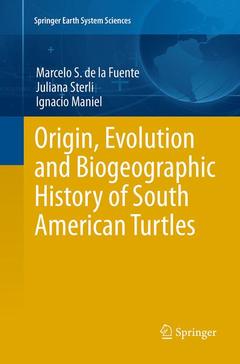Description
Origin, Evolution and Biogeographic History of South American Turtles, 2014
Springer Earth System Sciences Series
Language: English
Subjects for Origin, Evolution and Biogeographic History of South...:
Publication date: 08-2016
Support: Print on demand
Publication date: 10-2013
168 p. · 15.5x23.5 cm · Hardback
Description
/li>Contents
/li>Biography
/li>Comment
/li>
The extended continental South American turtle record (Norian to Lujanian) allows us to follow the evolution of this reptile clade from its origins. Several significant stem turtle taxa such as: Palaeochersistalampayensis and Condorchelys antiqua provide information on the first steps of turtle evolution. Others such as: Chubutemys copelloi or Patagoniaemys gasparinae provide clues to the origin of the bizarre horned tortoises of the clade Meiolaniidae. The panpleurodiran species such as Notoemys laticentralis or Notoemys zapatocaensis shed light on the origin of modern pleurodiran turtles. This book explores aquatic and terrestrial cryptodiran turtles, South Gondwana pleurodiran turtles, North Gondwana pleurodiran turtles; Meiolaniforms and early differentiation of Mesozoic turtles.
Introduction.- Aquatic cryptodiran turtles: the most recent island hoppers.- Tortoises: the oldest island hoppers.- South Gondwanan pleurodiran turtles.- North Gondwanan Pleurodiran Turtles.- Meiolaniforms: an extinct lineage of turtles of Gondwanan origin.- Early differentiation of Mesozoic turtles.
Marcelo S. de la Fuente studied at the Facultad de Ciencias Naturales y Museo de la Universidad Nacional de La Plata, Argentina. He has been a guest professor at the Muséum National d'Histoire Naturelle de Paris. He acts as a research member of the National Science Council of Argentina (CONICET) at the Museum of Natural History of San Rafael (Province of Mendoza). He is a published author of several papers in national and international journals on turtle systematics. His research interests involve the evolution and systematics of South American Meso-Cenozoic turtles.
Juliana Sterli studied at the Facultad de CienciasNaturales y Museo, Universidad Nacional de La Plata, Argentina. She is a research member of the Argentinian National Research Council (CONICET) at the Museo Egidio Feruglio of Trelew (Province of Chubut). Her research interests include cladistics (systematic biology), evolution, phylogenetics, Testudinata and vertebrate paleontology. She is a published author and works as a member of the Editorial Board of the Journal of Vertebrate Paleontology.
Ignacio J. Maniel has a degree in paleontology from the Facultad de Ciencias Exactas y Naturales, Universidad de Buenos Aires, Ciudad Autónoma de Buenos Aires, Argentina. He is a doctoral fellow of the Argentinian National Research Council (CONICET) at the Foundation of Natural History Félix de Azara (Ciudad Autónoma de Buenos Aires).His research interests include the evolution and phylogeny of pleurodiran turtles.
These books may interest you

Morphology and Evolution of Turtles 116.04 €

Morphology and Evolution of Turtles 116.04 €


